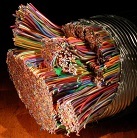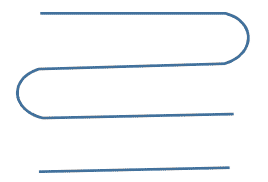Too Many Wires?

You have a long cable containing identical looking insulated wires. For every wire on east end of the cable you'd like to identify the corresponding end of that wire on the west end. Find the maximum value of for you to be able to do this in a single trip from the east to the west and back?
If you believe that there is no limit to the number of wires which can be identified, enter 0.
Details and assumptions:
-
You can label each wire on either end for identification.
-
On either end you can connect electrically any wire to any other wire or wires and isolate them electrically from any of the others. No other electrical connections may be made between the two ends of the cable.
-
You can determine if any two wires are connected on the opposite end by measuring resistance between them.
Image credit: Wikipedia
The answer is 0.
This section requires Javascript.
You are seeing this because something didn't load right. We suggest you, (a) try
refreshing the page, (b) enabling javascript if it is disabled on your browser and,
finally, (c)
loading the
non-javascript version of this page
. We're sorry about the hassle.
While it is not possible to use this method for any n (for example if there are only two wires, you can't tell them apart), there is no upper limit to what n can be. The trick is to realize that we know not only how many wires a given wire has been connected to originally and how many it is connected to now, but also which ones it was connected to (with the number of current connections of those connections) as well as which particular ones it is connected to now (and what their connections are connected to).
Let's start easy. Assume we have only four wires and no more than two of them are connected together on either end.
On the east end we start by connecting two of them. In the west we identify which two are connected and connect one of those to one of the others. Back east, we can identify wires as "not attached to anything anywhere," "attached here but not there," "attached there but not here," and "attached at both ends."
Now let's allow three wires to be attached to one another at the start, but add not just those three wires but also two attached to each other and a single wire to boot. Making the right (east) side of the pattern below.
To get the left (west) side, we connect one of the wires found to be connected to one other to any of the three single wires. This, together with the other of the two and an unattached single make up the bottom part of the pattern. To get the top (new) part, we find (1) the other pair of wires attached to each other and (2)the triplet. We connect one of the pair to one of the triplet. Finally we connect a second wire from the triplet to any of the remaining single wires. All of the wires eventually connected to the triplet are pictured int he upper part of the diagram. This entire pattern can be traced based on the limited information we have on our return to the east.
This procedure can be continued indefinitely. At n th step, we add n wires connected to each other on the east side, as well as a n − 1 of them, n − 2 , etc. all the way to a single wire. The connections on the west side will connect the n wires one at a time to n − 1 , n − 2 , etc. Then we connect the remaining n − 2 wires from the n − 1 bundle one each to the bundles just now connected from n bundle, except the last one which is now full. We continue the process until all are connected. All these will be identifiable by being (eventually) connected to the n -wire bundle.